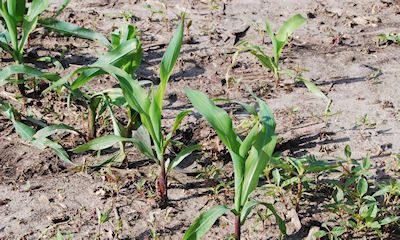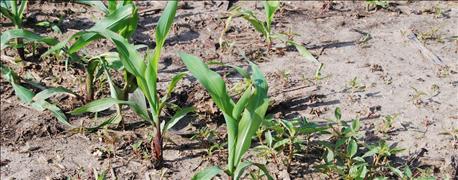
Corn planting this spring progressed quickly in many parts of the state that herbicide applications couldn't keep up with the planters. In some fields, corn is emerging before sprayers can get back in the field. While UAN (urea-ammonium nitrate) liquid nitrogen and many pre-emergence herbicide products can be applied to emerged corn, using UAN as a herbicide carrier enhances the foliar activity of products and may result in foliar damage to the corn.

CONSIDER YOUR OPTIONS: Corn planting progressed so quickly in many parts of Iowa this spring that herbicide applications couldn't keep up with the planters. Consider your options before applying herbicide and using UAN (liquid nitrogen) as herbicide carrier.
Check herbicide labels for restrictions on use of UAN as a carrier. That warning comes from Bob Hartzler and John Sawyer. Hartzler is an Iowa State University Extension weed management specialist and Sawyer is an ISU Extension soil fertility agronomist. They provide the following information and guidelines.
Risk of injury to corn depends on UAN rate applied
UAN alone can be applied to emerged corn, and the risk of injury to the corn is dependent upon UAN rate, corn stage and weather conditions. Conservative suggestions are to limit postemergence applications of UAN to 90 lbs. N per acre when corn is at the V3 to V4 stage of growth and to 60 lbs. N per acre at the V7 stage. Applications beyond the V7 stage are not recommended, and the risk of injury increases during hot, dry conditions.
The combination of herbicides with UAN greatly enhances the foliar activity of these products and poses a real threat of killing all emerged tissue contacted by the spray.
Some might try to rationalize this combination if the corn is at the VE-V1 stage since the corn's growing point is still underground. While corn often can recover quickly from loss of the shoot at this growth stage, the herbicide may influence the plant's ability to recover and therefore result in uneven plant size and yield loss.
Bob Hartzler is a professor of agronomy with extension, teaching and research responsibilities. He can be reached at [email protected] or 515-294-1923. John Sawyer is professor with research and extension responsibilities in soil fertility and nutrient management. He can be contacted at [email protected] or 515-294-7078.
Soybean seedling damage: Is there an interaction?
Is soybean seedling damage because caused by an interaction between ILeVO seed treatment and preemergence herbicides? This is another question ISU Extension agronomists are getting from some farmers these days.
Cool, wet conditions have led to soybean seedling damage that appears similar to seedling blights such as Pythium. However, the damage may be caused by a combination of cool, wet conditions, ILeVO seed treatments, and the application of preemergence herbicides. Questions have arisen—as farmers and crop consultants wonder if the phytotoxicity is more severe when ILeVO is used with preemergence herbicide treatments.
A team of plant pathologists from Iowa State University and Purdue University answer that question and provide their explanation in the current issue of ISU Extension's Integrated Crop Management newsletter. You can read their complete article online at www.extension.iastate.edu/CropNews/2015/0522Mueller.htm. The article is written by Daren Mueller, ISU Extension soybean plant pathologist and assistant professor in ISU's Department of Plant Pathology. He can be reached at [email protected] or 515-460-8000.
About the Author(s)
You May Also Like




